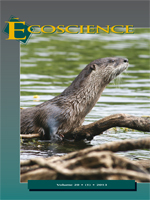It is generally assumed that blue and great tits (Cyanistes caeruleus, Parus major) compete for the same type of food (Lepidoptera larvae) during the breeding season and that the former have some advantage because they are usually earlier and can exploit small caterpillars that are often more abundant and are not consumed by great tits. However, it is not clear whether, when confronted with similar circumstances (e.g., nestling demand), blue and great tits show similar preferences for a particular caterpillar type. In this 2-y study, we compare the diet of both tit species in detail by controlling for hatching date and brood size. We also examine how the contribution of caterpillars and spiders to the diet is related to nestling development. A positive relationship was found between the percentage of spiders in the diet and nestling tarsus length in both species, reinforcing the idea that neonatal nutrition could have a strong influence on nestling phenotype (e.g., offspring size). Such a correlation may arise because spiders contain a high level of taurine, an essential nutrient in the early development of young, and/or this prey type contains more calcium than other food items, which may affect the rate of nestling bone mineralization. Blue tits fed their young double the number of tortricid larvae in comparison with great tits, whereas the latter showed a clear preference for noctuids and exploited, with a low frequency, a type of larvae not consumed by blue tits, hairy caterpillars (Lasiocampidae). Our results point to resource partitioning by these species in this forest ecosystem and contribute to a better understanding of feeding ecology of titmice, which is particularly timely in a global warming context.
How to translate text using browser tools
1 March 2013
Prey Choice, Provisioning Behaviour, and Effects of Early Nutrition on Nestling Phenotype of Titmice
Vicente García-Navas,
Esperanza S. Ferrer,
Juan José Sanz
ACCESS THE FULL ARTICLE

Ecoscience
Vol. 20 • No. 1
March 2013
Vol. 20 • No. 1
March 2013
comportement d'approvisionnement
early nutrition
Lepidoptera
Lepidoptera
nestling diet
nestling phenotype
nutrition néonatale




